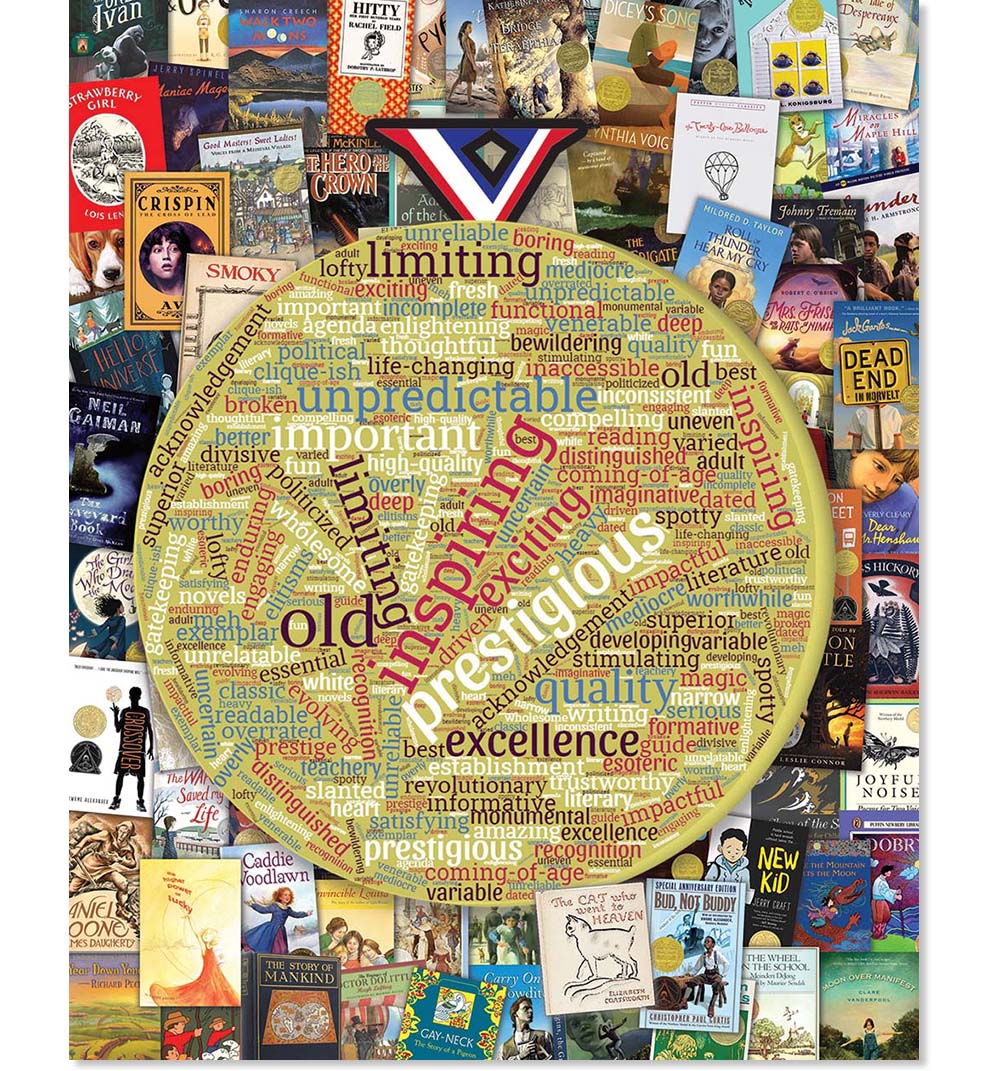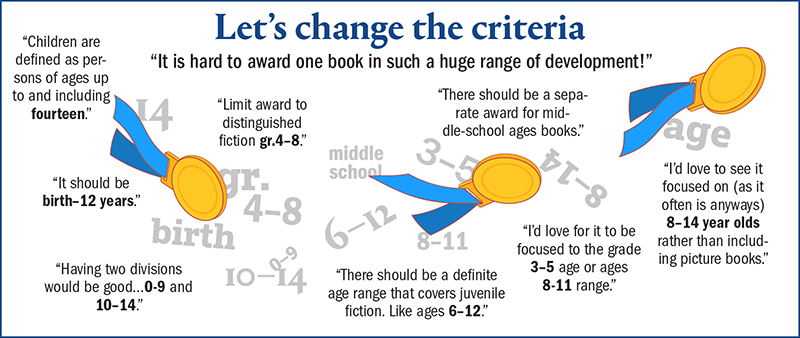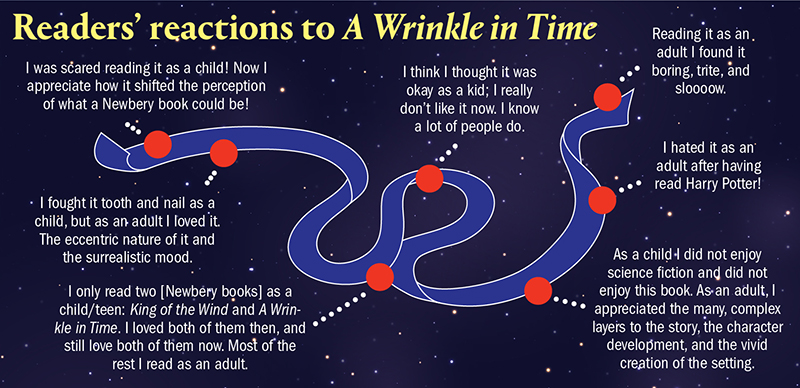Testing the Medal: Librarians' Opinions About the Newbery on its 100th Birthday
The Newbery Medal is as popular—and controversial—as ever. Here's what librarians have to say about it.

After 100 years, the Newbery Medal is as popular—and controversial—as ever. People have impassioned opinions. Lots of them. And they don’t hold back.
On “Heavy Medal,” the Mock Newbery blog that we cohost, we’ve been discussing the history of the award for the better part of this year. To cap it off this month, we created a special poll for SLJ to collect librarians’ and readers’ opinions on the Newbery process.
Our questions ranged from the fun (Which Newbery book that hasn’t yet been adapted would make the best film?) to the probing (What Newbery title is requested or checked out most from your library?) to the serious and reflective (What types of books are underrepresented among the winners?).
Our admittedly informal, weeklong poll elicited some 150 responses, a testament to the fame of the Newbery and the respect it earns among readers.
What single word did our respondents pick to describe the Newbery? “Prestigious” and “distinguished” topped the list. People also found it “compelling,” “exciting,” and “magical,” among the 57 percent of one-word descriptions with positive connotations. Twenty-seven percent of monikers were negative, including “limiting,” “incomplete,” and “broken,” while 16 percent were neutral: “meh,” “classic,” “writing.”
And do the kids value the Newbery sticker? In other words, how much do those titles fly off the library shelves? That question earned a 5.2 average ranking, on a scale of 1 to 10. The sticker has a middling influence.
A large number of respondents think the designated age category for Newbery readers is too broad. “The age range is honestly too large, and it is truly impossible to compare text meant for 0–14 years fairly,” one respondent stated.
Personally speaking
With a century of winners, it is safe to say that most of the titles were in print during our respondents’ life spans, and people read them as children, adults, or both. So how did their feelings about specific books evolve? For many, the emotional impact changed depending on their stage of life, particularly for A Wrinkle in Time and Bridge to Terabithia.
One reader said of The Midwife’s Apprentice: “As a child, I thought it was weird that this was a profession, and didn’t understand what was happening in the novel, given the ‘old’ language. Now, I think it is interesting and vital to see how far the world has come since olden times.”
In other cases, readers enjoyed certain books as children, including Island of the Blue Dolphins and Sounder, but later realized they contain offensive racial stereotypes.
Emily predicted that titles people read as children would be the ones they most commonly recommend. After all, this is someone who requested that her book club read The Westing Game as her birthday present. But it turned out that respondents were more likely to recommend titles published in recent years and are less satisfied with how historical titles hold up.
What were the judges thinking?
Every Newbery announcement inspires a great deal of excitement and some level of surprise. There’s a collective gasp in the announcement room, followed in recent years by a Twitter explosion. What titles should have won the top spot instead? We asked respondents to choose among 10 non-Newbery medalists. One led the way as expected: Charlotte’s Web earned nearly 50 percent of the votes. Interestingly, in the 1950s, Honor books were still labeled “runners-up” and ranked in order of votes. Yes, Charlotte’s Web placed second in 1953, behind Secret of the Andes.
We were happy to see two more recent acclaimed titles,One Crazy Summer (12 percent) and Brown Girl Dreaming (14 percent) had strong support as deserving non-medalists. Other than the titles we listed in the multiple-choice options, readers named another 74 books they thought were deserving. Among them were Wonder by R.J. Palacio and Sweep by Jonathan Auxier. As it turns out, each of those books was eligible during a year that one of us was on the Newbery committee, so we each know exactly how close they were to earning a seal…but we can’t tell you. All proceedings of the committee are completely confidential. Try checking back with Emily in 2069, though; confidentiality restrictions end after 50 years, starting with the 2016 committee.
What winner of the past decade surprised people the most? The overwhelming leader was a rare picture book Newbery winner:Last Stop on Market Street, the 2016 Medalist. A graphic novel, New Kid, the 2020 winner, was next on the list. That response suggests that it may be the type of book, more than the content, that creates the biggest Newbery announcement shocks. This also reflects our experience on “Heavy Medal.” Discussions of straightforward middle grade fiction are lively, but much less nuanced than the difficult, and sometimes contentious, conversations about how graphic novels, picture books, and borderline teen novels fit into the Newbery canon.
 Ninety-four different authors have won Newbery Medals, but our poll participants named another 62 writers whose work they think merited the award. Twenty of those named have won at least one Honor, leaving 42 that do not appear on any Newbery lists. And maybe this will be their year: Thirty-four of those authors published Newbery-eligible books in 2021.
Ninety-four different authors have won Newbery Medals, but our poll participants named another 62 writers whose work they think merited the award. Twenty of those named have won at least one Honor, leaving 42 that do not appear on any Newbery lists. And maybe this will be their year: Thirty-four of those authors published Newbery-eligible books in 2021.
If we could change the Newbery…
The range of Newbery winners has broadened in recent years, in terms of format, diversity, and content. Each year’s committee follows the official terms and criteria, which have remained fairly constant over the decades, despite occasional controversies. We asked readers to pick one of five sections from the criteria that is most ripe for change. The designated Newbery reader age range of 0–14 came up most as an issue, among 40 percent of respondents, but solutions varied. Debates about what a “distinguished” children’s book for 14-year-olds looks like arise frequently on “Heavy Medal”; Everything Sad Is Untrue and The Hate U Give are recent examples.
Thirty percent of respondents also took issue with the rule that “the Award is restricted to authors who are citizens or residents of the United States.”
They also weighed in on what types of books are still underrepresented. Nonfiction and graphic novels received the most votes in our multiple-choice poll. Some write-in comments cited genres that don’t win much, with humor and fantasy leading the way. Many pointed out the need for more diverse and inclusive content, though some also noted improvement in committees’ recognition of diverse content in recent years. Books that appeal to children, not just to adults who read kids’ books, also scored high as a missing element among winners.
Child appeal, cinematic visions
The Newbery is an “award for literary quality,” but that doesn’t always translate to widespread popularity. We asked poll participants to name the books that are most popular with kids. In a separate question, respondents named the books they most often recommend to young readers. New Kid and The One and Only Ivan led both categories. The kids’ choices leaned heavily toward newer titles, while the top adult recommendations reached back as far as the 1960s. Despite this, the same five books were named as the most popular with children and the most often recommended by adults.
What about cinematic depictions of Newbery titles? There were mixed responses as to whether some books should be made into a movie at all. One respondent didn’t want to see adapations of any winners, ever. “[A movie] could never be as good as the book, so none!”
Others expressed dissatisfaction with movies already created, such as A Wrinkle in Time and The Westing Game, with hopes that future filmmakers might produce better results. We saw lots of love for an imagined movie adaptation of The Graveyard Book, which could surely result in a spooky must-see. Disney is supposedly developing a live-action adaptation of Neil Gaiman’s tale, so readers may not need to wait too long.
The high levels of participation and passion in our mini poll show how deeply librarians care about the Newbery Award. There’s plenty of enthusiasm and excitement, but many also hold strong views about how the process might change and improve. Maybe children will have a place at the table in the future, more award categories will be created, or pictures will play a role in the judges’ decision. Now that we’ve hit the century mark, it’s only fair to wonder what the next hundred years will bring.
Steven Engelfried is library services manager at the Wilsonville (OR) Public Library. He served on the 2010 and 2013 Newbery Committees and the 2002 Caldecott Committee. Emily Mroczek-Bayci is a freelance children’s librarian in the Chicago suburbs. She served on the 2019 Newbery Committee. They blog at "Heavy Medal."
RELATED
The job outlook in 2030: Librarians will be in demand
The job outlook in 2030: Librarians will be in demand
ALREADY A SUBSCRIBER? LOG IN
We are currently offering this content for free. Sign up now to activate your personal profile, where you can save articles for future viewing









Add Comment :-
Be the first reader to comment.
Comment Policy:
Comment should not be empty !!!